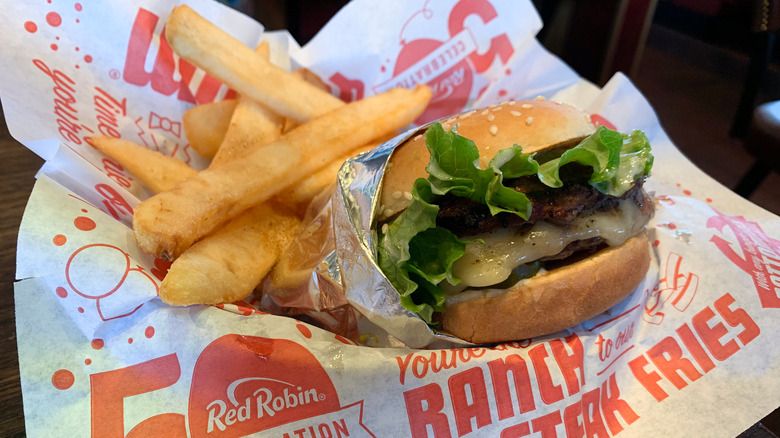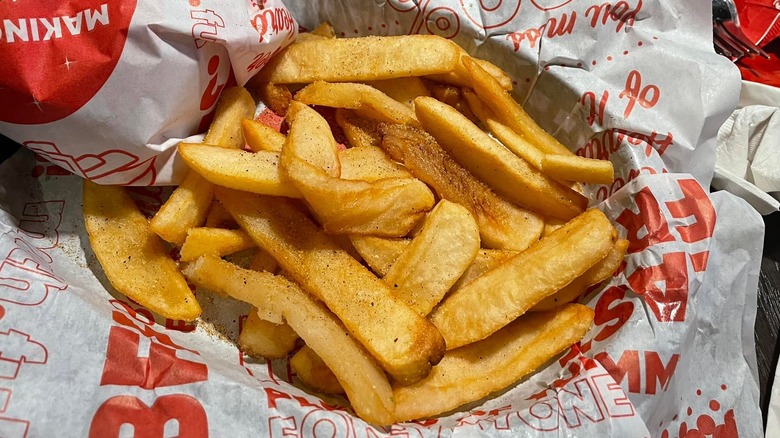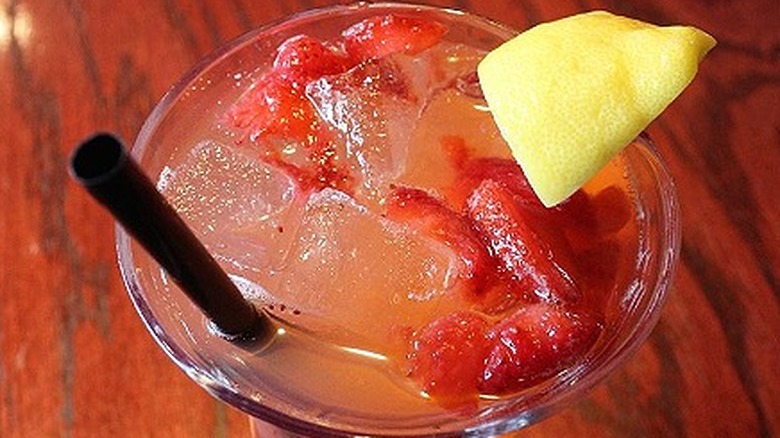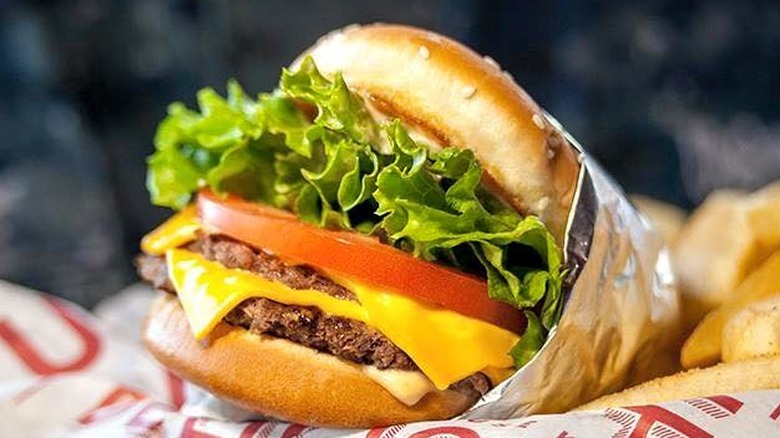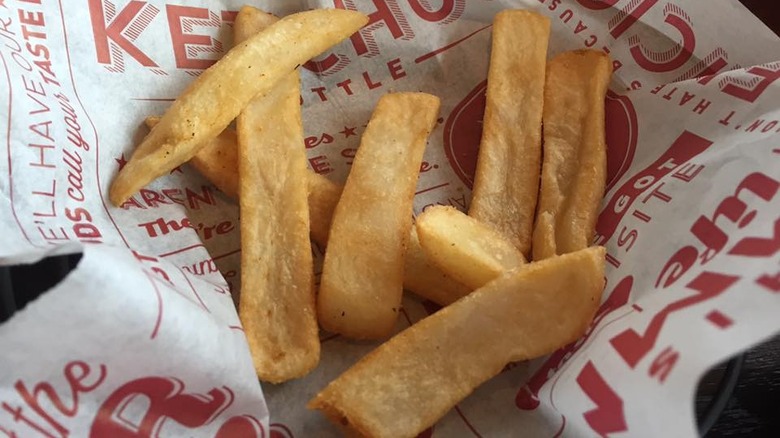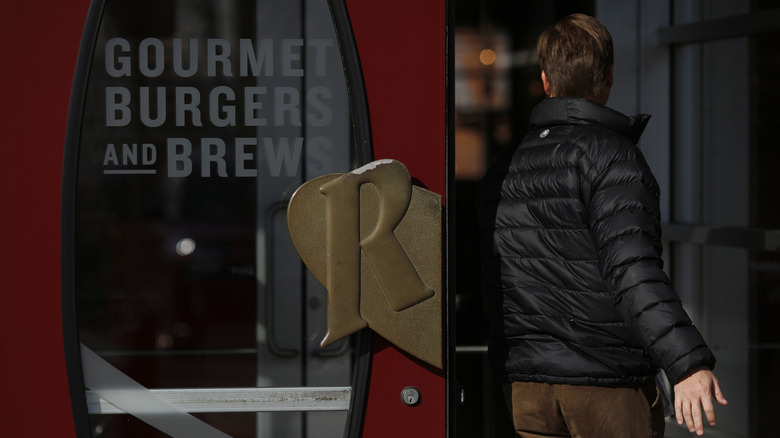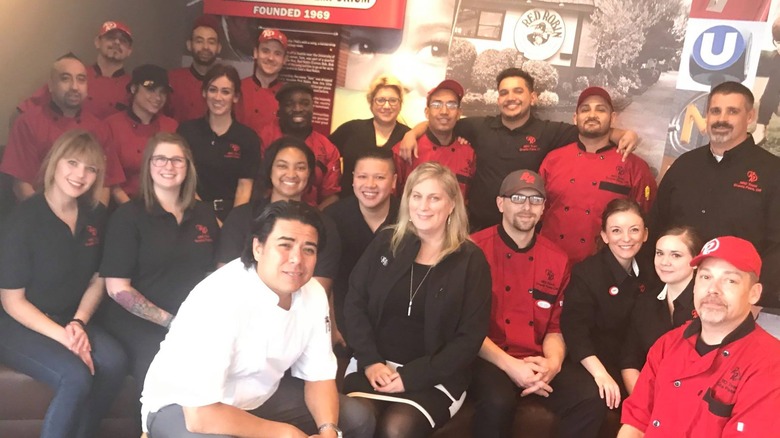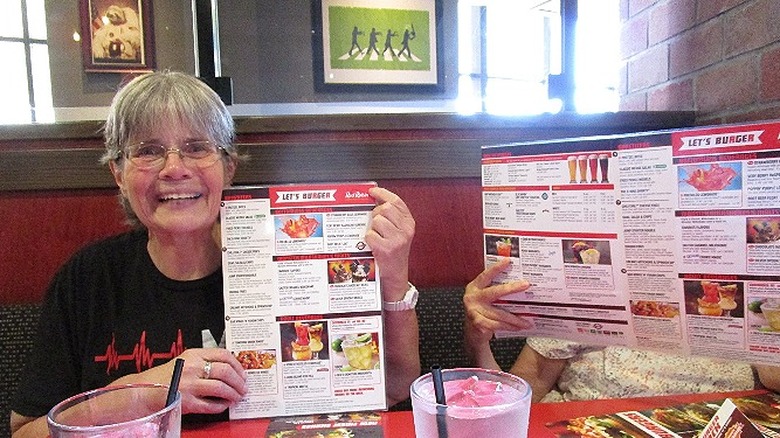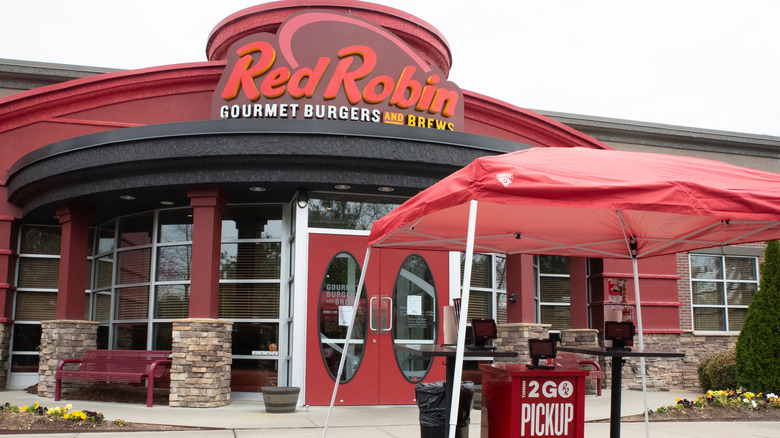We Finally Know Why Red Robin Is So Cheap
We may receive a commission on purchases made from links.
Red Robin is a beacon for burger-lovers everywhere. What started as a humble little tavern in 1969 has since unleashed into a rockin' restaurant empire slinging mouthwatering burgers and bottomless fries with retro flair. Fun and family-friendly, it's not hard to see why the Colorado-based franchise has expanded to over 500 locations across North America (via Red Robin).
However, it's easy to assume the cheerful chain also faces stiff competition. When dollar menu cheeseburgers are just a drive-thru away, the dependably mid-priced fare seems almost antiquated in comparison. After all these years, however, they've remained surprisingly affordable. In a survey spanning 20+ restaurants, investment company Morgan Stanley found them to offer the best deal for eating out at just $12.17 per person, according to Yahoo! News — that's with free refills included.
This begs the question then of how they've managed to keep prices down for as long as they have. What tricks lay up their sleeves for conjuring baskets of bottomless fries or lemonade by the glassful? Is it simply an illusion, or the result of careful planning and strategic shortcuts? Per Meat + Poultry, Red Robin prides itself on "affordable abundance," where good value replaces quick gimmicks, letting customers always expect high quality above all else. As of 2018, it has also been working to improve wait times during peak hours. Here are some of the secrets behind how Red Robin satisfies its customers while maintaining its profit margins.
Red Robin's bottomless fries are frozen
Unless you're In-N-Out, it's a rarity for fast food restaurants to make their fries from scratch and Red Robin is no exception. The restaurant opts for frozen fries instead of fresh, a fact that shouldn't surprise anyone who has cleaned out multiple baskets with their Tavern Double. Not only would the labor cost be exponentially higher if spuds were hand-cut by employees, but the cost of fries on the menu would be a lot higher — and they might not be bottomless with every burger.
This was confirmed by a manager from Red Robin, who took to Reddit to explain the process. According to the post, the frozen fries are delivered to the restaurant in boxes, with each box containing six 5-pound bags of spuds. The potato wedges are then dumped into the fryers for 5-6 minutes before being doused in salt and quickly served. The employee also confirmed they receive 80 boxes a week, which translates to 2,400 pounds of French fries. Keep in mind that's just one location; the franchise's busiest restaurant, meanwhile, is famous for slinging up to 5,000 pounds of spuds a week for the 8,000+ diners who stroll through its doors (per KREM). Even if French fries are cheap, that's still a lot of fries, let alone the potatoes needed to keep up the supply. It simply wouldn't be logical for Red Robin staff to prepare its fries on-site in addition to the rest of the menu.
They serve Minute Maid lemonade
Sipping strawberry lemonade in those fun twirly glasses is always a treat, especially when you know a refill is on the way from your server. The reason the fruit beverage is able to flow the way it does is because Red Robin doesn't make its lemonade by hand. On the contrary, they use store-bought lemonade to craft their drinks. Minute Maid Lemonade, that nostalgic childhood fuel, serves as the base of the burger joint's Freckled Lemonade and Flavored Lemonade that's available in raspberry or peach. The chain doesn't hide the fact that it relies on the longtime juice brand. As a matter of fact, the name is blasted all over the restaurant website and promotional materials, letting you know the partnership goes all the way to the bottom (pun intended).
To be honest, it's unclear what Red Robin's lemonade supply looks like. What we do know, however, is that Minute Maid is reliable, easy to find, and most importantly, cheap. It's carried by most major retailers like Target and Wal-Mart and sold for between $2-6, depending on its packaging (bottles, cans, etc.). Red Robin can pump out an unlimited supply without footing the bill on fresh juice and the labor needed to extract it. Customers only pay the menu price once, as the refills are already factored into the total. Is freshly-squeezed lemonade poured from a pitcher better than its artificially-sweetened counterparts? Yes, probably. Is it cheaper? Definitely not.
They use American cheese
Red Robin advertises itself as a gourmet burger chain, and for the most part, it lives up to this marketing tactic. Artisanal beef works, like The Southern Charm Burger or Black & Bleu, certainly come to mind when we think of Red Robin. That doesn't necessarily mean everything on the menu will be gourmet, however. Many of Red Robin's patties are actually draped with American cheese, that rubbery, neon-yellow substance that is so processed it can't be legally categorized as cheese by the Food & Drug Administration (FDA). Despite its negative reputation, it also makes a fantastic burger topper for its melty consistency and mild tang (via Serious Eats). In Red Robin's case, it's featured most prominently on the Tavern burgers, the chain's budget-friendly lineup boasting smaller patties at a smaller price.
But American cheese is also cheaper, and if you take the average price for common cheeses into account, you'll see how American wins for overall affordability. According to The CheeseMaker, Cheddar averages about $3.36-9.07 per pound, while Swiss ranges from $3.44-9.31 for the same amount. American cheese is a downright bargain at just $2 minimum. Most toppings besides the meat are pretty cheap for a burger — lettuce, tomato, onion, mayo — yet fancier cheeses could ring up the cost. By skipping the premium ingredients, Red Robin can sell a juicy burger at the fraction of the cost and get away with it, which is how they stay so cheap.
They reuse oil
To achieve that golden brown crunch, Red Robin's fries are submerged in fully-refined soybean oil, clear of major allergy-inducing ingredients (via AllergyEats). While the French fries may be bottomless, as it turns out, the loads of oil fueling the fryers are not. That's why the burger chain reuses its oil on a regular basis. This keeps prices down while delivering on the promise of infinite steak fries that customers have come to expect. Oil costs money, and the amount of food the restaurant prepares every day can add up if there aren't measures taken to preserve resources.
Aside from saving money, recycling oil has an environmental purpose, too. In a Reddit thread discussing possible cross-contamination across the restaurant's fried items, users broke down the reasons for Red Robin's process. "Fryers in general will recycle oil because of the amount of waste if they don't," one commenter replied, while another claiming to be a line cook at Red Robin chimed in that "The oil that gets filtered goes into the same fryer, but there will be excess oil that can get into the next fryer down the line, which is why we do the seafood fryer last (allergies and whatnot)." This also aligns with Red Robin's efforts toward renewable energy.
Many Red Robin patrons have noted that specific locations have catered to their dietary needs in the past, as cited in the Reddit thread. However, some workers claim that the fryers themselves are all the same.
Consistent prices draw customers
Unlike its competitors, Red Robin doesn't really offer discounts — not in the traditional sense, at least. Instead, the company prides itself on "affordable abundance," a phrase former CEO Denny Marie Post used to describe the chain's emphasis on reliable pricing over flashy markdowns (per Meat+Poultry). When customers stop by for a burger and fries, they'll be able to expect the same prices and generous portion sizes, no matter what location they go to. Red's Tavern Double will always cost $6.99 — no more, no less. It may cost more than the value menu, but in return, you're receiving heaps of food at a flat rate. This makes it an especially appealing option for those looking to get more for their money.
Consistency is just as important as low prices, yet maintaining identical levels can be difficult when outside factors refuse to cooperate. Take price hikes, for example. At the 2018 Restaurant Franchising and Innovation Summit, Chief Operating Officer Carin Stutz noted a past cost increase in ingredients crucial to any Red Robin: beef and French fries (via Fast Casual). Yet because customers come to expect low-ish prices, or "affordability," the chain has to decide whether to keep prices low or raise them to meet commodity prices. It's a philosophy that makes sense when you consider Red Robin's priorities. Consistently reasonable prices fare better in the long run for repeat visits, which allows Red Robin to remain so cheap in the restaurant sphere.
Red Robin cuts labor costs
Have you ever wondered how Red Robin could afford those drink refills? The reason endless streams of lemonade are possible is because the restaurant reduces labor costs to keep things cheap for its customers. By and large, it ends up being its employees who pay the price — literally. On average, Red Robin workers are paid $16 an hour, with servers and waiters on the lowest end of the scale (via Indeed). This doesn't largely differ from the industry's national average of about $16 per Indeed, but pay rate remains a glaring fact restaurant chains like Red Robin can't deny: reducing the cost of labor (i.e. workers) reduces the menu prices. It's what lays behind the free bottomless fries you get with every burger, no questions asked.
Cutting labor costs is nothing new for the popular hamburger chain. In 2018, Red Robin scrapped busboy and expeditor positions to stave off minimum wage increases around the country (per Nation's Restaurant News). In addition, Kiosk Marketplace reported last year that the chain signed a contract with Ziosk, a tablet device that allows diners to pay for their meal at the table. This kind of automation seems harmless enough — who can argue with customer convenience? — but the human side of the labor chain will be impacted, whether it's an outcome Red Robin wants or not. If more automation is implemented at Red Robin locations, there will inevitably be less of a need to rely on workers.
The tiered menu helps food stay cheap
It seems there's a burger for every appetite and budget at Red Robin, and that's on purpose. In order to bankroll cheaper items, the burger chain offers a tiered menu covering a variety of price points from lowest to highest. Tavern burgers are the most affordable, Gourmet burgers are the middle-ground, and the Finest burgers are the most expensive. The strategy, as Business Insider reports, was implemented to compete with the shifting consumer trends that have emerged as a result of the pandemic. For the most part, it's worked. By serving a little bit of everything, Red Robin can eat the costs of its budget-friendly fare, so long as pricier items are able to make up the difference in the overall bottom line.
Let's look at the Tavern burger for a moment. One would assume a tasty burger at an even tastier price ($6.99) would be enough competition to drive the lion's share of profits, right? Surprisingly, that wasn't the case. CEO Denny Marie Post attributed low profits in 2018 to the menu's proliferation of Tavern burgers, leaving higher-priced burgers left in the dust (via Meat+Poultry). The solution? The company decided to whittle down the selection, with plans to rotate them at will. Customers get to enjoy dining out on their own budget, while the restaurant reaps sales from every direction. In other words, the situation is a win-win that allows Red Robin to stay cheap.
Red Robin streamlines the menu
Before the pandemic hit, Red Robin was a bustling burger destination. The shuttering of dining rooms and newfound customer expectations, such as eating at home and spending less, forced the restaurant to retool its business strategy. Turns out, downsizing the menu is actually a money-saver. According to MarketWatch, the company purged over 50 menu items in 2020 to streamline the ordering process. Covering everything from appetizers to desserts, casualties included the Chili Chili Cheeseburger, Chocolate Fruffles, and the Freckled Lemonade Smoothie (via Eat This, Not That). In total, 55 menu items were permanently cut amidst the pandemic. It's also worth noting that as of June 2020, about 62% of Red Robin's sales could be attributed to off-premise dining as more customers leaned toward takeout and delivery.
Knowing how attached customers get to their favorites, this decision could have easily backfired for the restaurant. However, paring down the options actually paid off. Red Robin Chief Executive Paul Murphy III said it produced "little-to-no negative guest feedback," and it "improved back-of-the-house speed and efficiency," resulting in fresher, better-tasting food (per MarketWatch). In other words, scaling back on how much is offered at a time saves Red Robin money because it's less labor, ingredients, and time spent preparing for items that may not be sought out. All of this saves money that could go toward better-performing entrees on the menu. To go back to that much-repeated adage, sometimes, less really is more!
